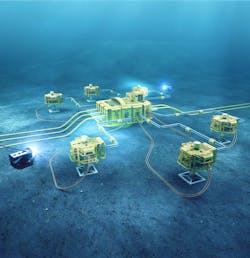New DNV GL recommended practice advances subsea equipment standardization
Offshore staff
OSLO, Norway – DNV GL has issued a recommended practice (RP) for subsea pumping systems that targets cost reduction and environmental gains.
DNVGL-RP-F303 Subsea pumping systems provides a comprehensive specification for subsea pumping systems and complements existing industry standards.
The RP is applicable for single phase, hybrid, and multiphase pumps. It covers five design categories for pressure-containing equipment with pressure ratings up to 15,000 psi (1,034 bar); and three design categories for water depths down to 3,000 m (9,843 ft). Applications include modular-based mudline pumping systems for pump station, processing system, subsea production systems, water injection, and dual lift.
Its content, intended for use as a requirements reference for use in subsea pumping projects covers: standards, functional requirements and specifications; TQ work processes and test requirements; pump modules and pressure-containing equipment; control systems and instrumentation; materials and welding; system design; and power system.
The RP was published following a joint industry project including operators Equinor, Petrobras, Shell, and Woodside, and systems suppliers Aker Solutions, Baker Hughes, OneSubsea, and TechnipFMC.
The project sought to address several obstacles to subsea processing and pumping. These include overcoming the industry’s perceived novelty and unfamiliarity of subsea processing technology which can prevent new projects from being sanctioned, even though the concept is proven. Dozens of subsea pumps have been installed and several have been in operation for more than a decade, for example, offshore Norway and Angola.
Lower emissions and the decarbonization of processes are the benefits of adopting energy efficient subsea processing systems when compared to conventional upstream facilities, DNV GL said. This is due to the reduction in topsides equipment and use of less electrical power when boosting closer to the wellhead.
DNVGL-RP-F303 also:
• Helps companies to reduce costs by providing increased predictability and clear requirements for projects
• Provides guidance and simplifies how to perform a risk-based approach when witnessing the manufacturing and testing processes
• Contributes to further standardization in the subsea industry
• Offers predictable requirements and standardized product results leading to increased confidence in the subsea pumping system
• Increases the reuse of qualified technology with minimum test requirements to reach Technology Readiness Level 4.
The company said the RP can also serve as a contractual reference document between purchasers and suppliers and recommends roles and responsibilities among the parties in the value chain to increase efficiency.
Kristin Berg, Head of Section, Subsea Technology, DNV GL – Oil & Gas, said: “Fields frequently operate tailor-made subsea solutions involving extensive technology qualification programs. Special installation tools are needed, often on specialized vessels.
“The thinking behind the joint industry project was to increase alignment and predictability of requirements for subsea pumping projects. This can open the door to repeat projects and the reuse of qualified technology, which can reduce costs and address the perception of technology risk.”
Liv A. Hovem, CEO, DNV GL – Oil & Gas, added: “Investment in subsea oil and gas production is growing rapidly as the industry realizes the significant cost efficiencies the technology can bring compared with traditional approaches to production. The challenge is that everyone is implementing subsea systems slightly differently, creating the potential for cost inflation in the supply chain.
“Starting with subsea pumping, this new RP works toward standardizing this sector from the outset to keep costs optimal for the long term.”
10/31/2019
